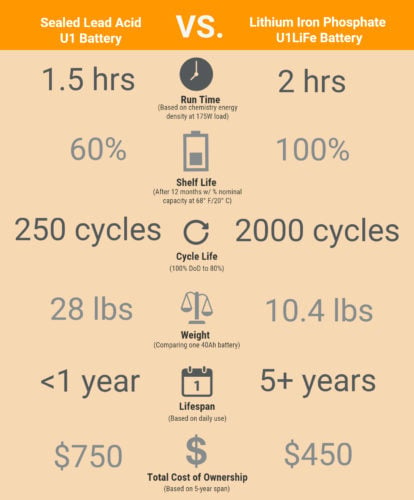The use of antiquated lead acid batteries to power portable medical equipment can lead to inefficient and costly processes and procedures. Longer life Li-iron Phosphate batteries can replace older technology resulting in significant cost and time savings. Inventus Power offers U1LiFe batteries with long run times, high cycle lives and smart features.
Medical equipment tends to follow one of a few different use models for portable power. One-time use, disposable products use conventional alkaline batteries. Portable devices, such as oxygen concentrators or portable ventilators, requiring light weight and long run times have adopted Li-ion battery technology. There is also a large segment of medical equipment that is intended to use batteries as backup power only. Because electric companies cannot always provide uniform power, stationary medical devices use AC electrical power from the grid with an Uninterruptable Power Supply (UPS) to protect against power outages and voltage drops/spikes. A battery is intended for use as a backup or when the device is being moved around the hospital. These devices and their UPS systems have typically been designed for use with sealed lead acid (SLA) batteries, but new Li-iron Phosphate batteries such as the U1LiFe can be a drop-in replacement for older technology, resulting in long-term cost savings and other advantages.
SLA batteries: low cost, but not portable
 In addition to their extremely low cost, SLA batteries have a few technical traits that have kept them prevalent in backup applications. Most notably, they can be float charged in a high state of readiness without the loss of cycle life that would be seen in other chemistries.
In addition to their extremely low cost, SLA batteries have a few technical traits that have kept them prevalent in backup applications. Most notably, they can be float charged in a high state of readiness without the loss of cycle life that would be seen in other chemistries.
A better solution
Conventional Li-ion chemistry is designed to offer the highest energy density by size and weight. Newer Li-ion chemistries, such as Li-iron Phosphate-based cells, have remarkable cycle life, high-current delivery capability, increased safety and low impedance. Their voltage also matches well with SLA at 12 and 24V increments and allow use with conventional SLA chargers. Most importantly, Li-iron Phosphate batteries yield the longest cycle life of any commercially available technology, as many as thousands of cycles and several years of operation.
The most common standard SLA form factor used in medical equipment backup applications is the U1 and this size is now available from Inventus Power utilizing Li-iron Phosphate chemistry and incorporating smart features such as state-of-charge and cycle count communication at about a third of the weight. Inventus Power’s U1LiFe batteries offer a long run time and maintain 100% capacity in storage, unlike SLA batteries which experience permanent capacity loss within a few months of storage. With a cycle life in the thousands, a lifespan extending five years, and no maintenance costs, a U1LiFe’s total cost of ownership far exceeds that of an SLA battery, resulting in an overall better solution.
Learn more about Inventus Power’s U1LiFe Batteries.
This article was originally published in Medical Device Developments Magazine, 2016 Volume 2